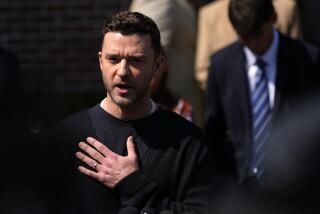Drunk Driving Penalties
- Share via
Stanton Peele’s article (Editorial Pages, June 19), “Harsh Penalties for Drunk Driving May Miss the Target,” gives the public an incorrect concept of the law and how courts enforce it.
1--Peele seems to sympathize with the plight of the “mildly intoxicated driver” and to feel that “many Americans will perceive (his treatment by the law) as unjust.”
It isn’t the “mildly intoxicated driver” who is prosecuted. By the time one reaches .10 of 1% blood alcohol when tested, that driver probably still has the alcohol from at least 5 standard bar whiskeys or cocktails, or 5 cans of beer in his bloodstream.
Such drivers are impaired in the basics of driving safety such as depth perception, peripheral vision, light recovery, stopping time, and above all, judgment.
They get home without an accident only through sheer good luck. No emergency has arisen requiring defensive driving.
Where a sober driver copes safely with emergency possibly a dozen times a day, the driver who is under the influence will be slow in reacting even if he takes the appropriate defensive measure, which is dubious. He will have lost the margin of safety he would otherwise have had.
2--The crime is not one of “substance abuse,” as the writer of the article suggests. It is a crime of “people abuse.” A case for leniency can be made for a first offender. If he has what educators have called the “apperceptive germ” he will benefit from a driver education program.
After that, it is a crime of selfishness. The driver knows it’s wrong, he knows it’s risky, he knows, however dimly, that he can be responsible for great tragedy, for deaths, for maiming, but he can’t be bothered waiting to sober up or to get home another way, or even not to drive in the first place if he knows he is going to be drinking heavily. He gets behind the wheel and takes the chance--devil may take the others on the road for all he cares.
The crime has been committed when he takes to the highway. Remember that the second or multiple offender has been stopped previously by police, has had to take roadside sobriety tests, has been handcuffed, transported, booked, photographed, fingerprinted, and jailed, even if only for a brief period before bailing out. That should be (and most of the time is) enough for the average individual to experience in his entire lifetime. The one who repeats the act, notwithstanding the previous experience, identifies himself or herself as a callous, uncaring, and dangerous individual.
3--Peele wrote: “The result has been the same harsh treatment of the driver with a .10 blood alcohol level and the extremely intoxicated driver.”
No. Not at all. Courts have under the statute a wide range of penalties available, even for a first offense, ranging from a mere fine to six months in jail, and including the possibility as well of impounding the violator’s vehicle, and suspension of his license. The court will base its judgment on considering the report of the incident, or the testimony it has heard at trial. Each fact situation is unique.
4--There is no rational basis for comparing the proscription against driving under the influence with Prohibition, as Peele does in his article. There is not even the remotest possibility of “disobedience on a massive scale,” as he suggests. The general public is overwhelmingly in favor of the law. In fact I have noted that many citizens believe the penalty for a first offense is far too light--that if there were a mandatory minimum time in custody for a first offense, many violations would never take place.
5--Peele wrote: “It is possible for the reckless driver who kills someone to receive a milder punishment than a slightly intoxicated driver.”
It is most assuredly not possible. A “slightly” intoxicated driver would not be charged with driving under the influence. He would have to be .10 or over; and .10 or over is not a “slightly” intoxicated driver. It is a substantially impaired driver.
6--Peele wrote: “Perhaps the very drunk driver . . . should be kept off the roads.”
Certainly the repeat offender, driving without a license, and in violation of prior probation, has forfeited the kindly concern of a judge. He has identified himself as a scofflaw, a menace to the life, livelihood and dependents of his potential victims. There is only one way to delay tragedy--incarceration for as long a period as the law allows.
JUDGE ROY M. CARSTAIRS
Municipal Court
Los Angeles
More to Read
Sign up for Essential California
The most important California stories and recommendations in your inbox every morning.
You may occasionally receive promotional content from the Los Angeles Times.













